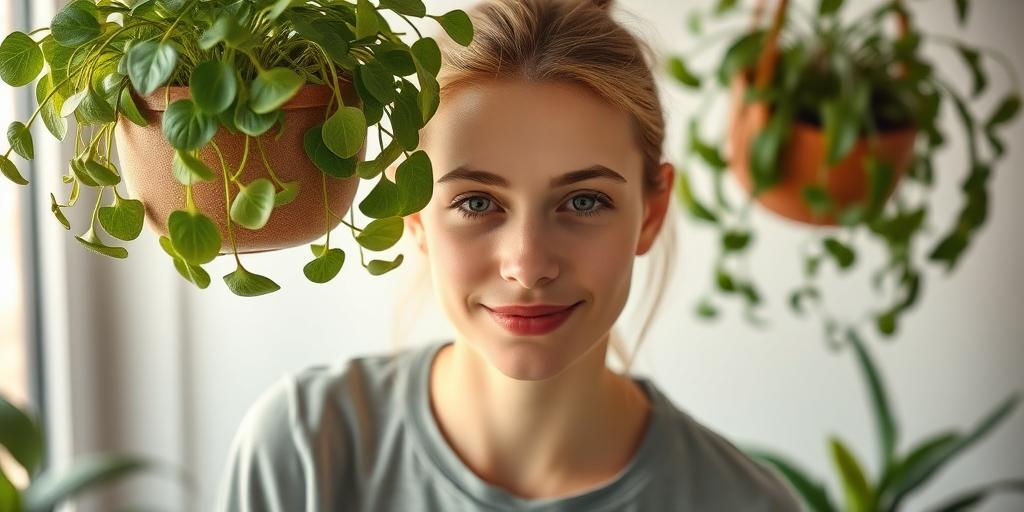
Top 7 Easy-Care Hanging Plants for Low Light (2025)
Discover the best low-light hanging plants that thrive with minimal care! Perfect for beginners or busy plant lovers, these 7 easy-care options will brighten up any dim corner.
Introduction
Do you love the lush look of hanging plants but struggle with low-light spaces? You’re not alone! Many homes and offices lack bright, direct sunlight—but that doesn’t mean you can’t enjoy beautiful, trailing greenery. In fact, some of the easiest plants to care for actually prefer shady spots! Whether you’re a busy plant parent or a beginner looking for foolproof options, this guide covers the top 7 low-light hanging plants that require minimal effort. From the ultra-forgiving Pothos to the elegant Spider Plant, these varieties will thrive even in dim corners. Let’s dive in!
Pothos (Epipremnum aureum)
If you’re looking for a low-maintenance plant that thrives in low light, the Pothos is a top contender. This hardy vine adapts well to indirect light and can even tolerate fluorescent office lighting. It’s forgiving if you forget to water it occasionally, making it perfect for beginners or busy plant parents.
Care Tips:
Pothos isn’t picky—water it when the soil feels dry to the touch. Overwatering can lead to root rot, so err on the side of underwatering. One of its coolest features? It can grow in water indefinitely, making it a great choice for hydroponic setups or simple propagation.
Varieties to Try:
-
Golden Pothos: Classic green leaves with yellow variegation.
-
Marble Queen: Cream and green marbled foliage.
-
Neon Pothos: Bright, lime-green leaves that add a pop of color.
Spider Plant (Chlorophytum comosum)
Spider plants are practically foolproof, thriving in low to moderate light while producing adorable “spiderettes” (baby plants) that dangle from long stems. They’re also fantastic natural air purifiers, removing toxins like formaldehyde from indoor air.
Care Tips:
Keep the soil slightly moist but not soggy. Spider plants love humidity, so misting them occasionally or placing them in a bathroom can help them flourish. If the tips of the leaves turn brown, it might be due to fluoride in tap water—try using filtered or distilled water instead.
Bonus:
These plants are non-toxic, making them a safe choice for homes with pets (though some cats may find the dangling spiderettes irresistible to play with!).
Philodendron Heartleaf (Philodendron hederaceum)
With its fast-growing vines and heart-shaped leaves, the Heartleaf Philodendron is a favorite for low-light spaces. It’s incredibly forgiving, bouncing back even if you neglect it for a bit.
Care Tips:
Water when the top inch of soil feels dry. This plant loves to trail, so it’s perfect for hanging baskets or shelves where its vines can cascade freely. If you want a bushier look, simply pinch back the stems to encourage new growth.
Pro Tip:
It’s toxic to pets, so keep it out of reach if you have curious cats or dogs.
String of Hearts (Ceropegia woodii)
This delicate trailing plant features tiny heart-shaped leaves on slender vines, adding a whimsical touch to any space. While it prefers bright, indirect light, it can tolerate lower light conditions—just expect slower growth.
Care Tips:
Let the soil dry out completely between waterings to prevent root rot. Overwatering is the quickest way to kill this plant. If you notice the leaves thinning or losing color, it might need a bit more light.
Fun Fact:
String of Hearts can produce small, tubular flowers under the right conditions, adding an extra layer of charm.
ZZ Plant (Zamioculcas zamiifolia)
If you’ve struggled to keep plants alive, the ZZ Plant might be your savior. It’s nearly indestructible, tolerating low light and long periods without water. Its glossy, dark green leaves add a modern, sculptural element to any room.
Care Tips:
Water sparingly—once every 2-3 weeks is usually enough. The ZZ Plant stores water in its rhizomes, so it can handle drought-like conditions. Overwatering is its biggest enemy.
Why It’s Great for Beginners:
It thrives on neglect, making it ideal for forgetful waterers or those with less-than-ideal lighting.
English Ivy (Hedera helix)
A classic trailing plant, English Ivy is not only beautiful but also an excellent air purifier. It thrives in low light and cooler temperatures, making it a great choice for less sunny spaces.
Care Tips:
Keep the soil consistently moist but not waterlogged. English Ivy appreciates humidity, so occasional misting can help prevent spider mites. If the leaves start to yellow, it might be getting too much water or not enough light.
Note:
While it’s a great indoor plant, English Ivy can be invasive outdoors, so keep it contained if planting outside.
Peperomia (Peperomia spp.)
With over 1,000 species, Peperomia offers a wide variety of leaf shapes, colors, and textures—from ripple-like leaves to deep red hues. These compact plants do well in low to moderate light and are perfect for small spaces.
Care Tips:
Water only when the soil is dry to the touch, as Peperomias are prone to root rot. They store water in their thick leaves, so they can handle occasional neglect. Avoid placing them in direct sunlight, which can scorch their foliage.
Popular Varieties:
-
Peperomia obtusifolia (Baby Rubber Plant): Thick, glossy leaves.
-
Peperomia caperata (Emerald Ripple): Deeply textured, heart-shaped leaves.
-
Peperomia argyreia (Watermelon Peperomia): Striking silver-striped leaves resembling watermelon rinds.
Each of these plants brings its own unique charm while thriving in low-light conditions, making them perfect for brightening up dim corners of your home or office.
Conclusion
Who says low-light spaces have to stay dull? With these 7 easy-care hanging plants, you can transform any dim corner into a lush, green oasis—no green thumb required! Whether you choose the hardy ZZ Plant or the cascading String of Hearts, each of these plants brings beauty with minimal effort. Ready to brighten up your space? Pick your favorite and let the greenery work its magic!
